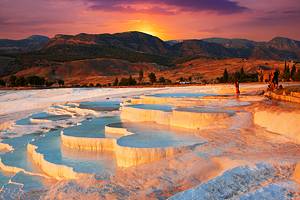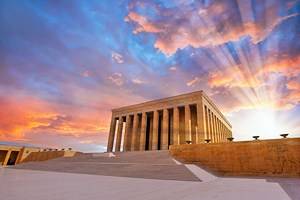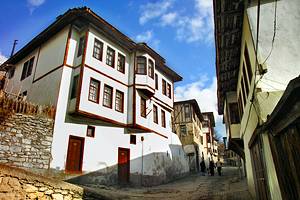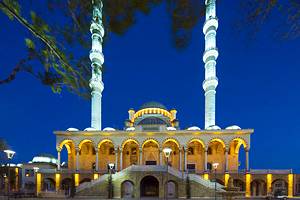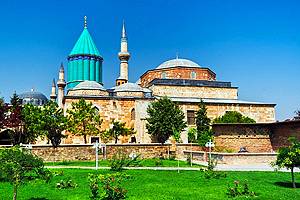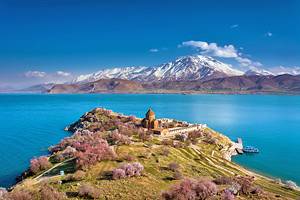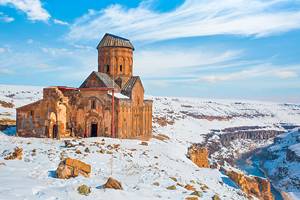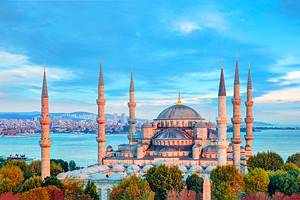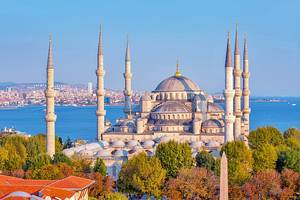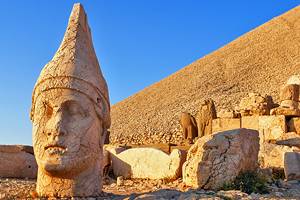Visiting the Atatürk Mausoleum (Anıtkabir)
One of Turkey's most notable examples of modern architecture, the Atatürk Mausoleum sits high on a hilltop in Ankara, the country's capital.

Designed by Turkish architect Emil Onat, the complex was constructed between 1944 and 1953 to be the final resting place of Mustafa Kemal Atatürk, the founder and first president of the Turkish Republic.
Before the building was finished, Atatürk's remains were housed in Ankara's Ethnographic Museum. They were brought here, to lie in state, on November 10th 1953 to mark the 15th anniversary of his death.
The mausoleum complex is mammoth, with a grand staircase known as the Path of Honor, flanked by reclining Hittite lions, leading up to the Court of Honor where the mausoleum itself and a museum dedicated to Atatürk's life both sit. There are excellent panoramic views across Ankara from the Court of Honor.
For visitors to Ankara, the building is both one of Turkey's most prominent examples of mid-20th century architecture and an important symbol honoring Atatürk and the birth of the republic.
Overview

A flight of 33 steps made from the volcanic tufa rock of Cappadocia leads up between the twin Towers of Liberation and Independence to the 260-meter-long Path of Honor.
On either side of this 30-meter-wide avenue are sculpted groups of three female and three male figures, representing Turkey's transition from Ottoman traditionalism to the modernity of Atatürk's Republic.
At the far end of the boulevard, the entrance to the courtyard (called the Ceremonial Plaza) is guarded by two more towers symbolizing the Turkish army and defense of national rights.
The courtyard, laid with travertine blocks, can fit up to 15,000 people and is hemmed by colonnaded buildings. The towers on each corner signify peace, victory, revolution, and the republic.
The colonnaded Hall of Honor on the east side of the courtyard houses the Atatürk and War of Independence Museum underneath it.
The edifice on the south side is the mausoleum of Turkey's second president, Ismet Inönü.
The Mausoleum

The mausoleum itself, on the northern side of the courtyard, is a starkly simple piece of architecture befitting Atatürk's rejection of the ornate pomp and splendor of the Ottoman era.
The austere, Brutalist feel of the building is in direct contrast to most other sites travelers will encounter while sightseeing around Turkey.
Reached by a monumental staircase of 33 steps, the 55-meter-wide and 21-meter-high building bears down on the courtyard; its sheer size makes ornamentation unnecessary.
On either side of the platform terrace, bas reliefs depict scenes of the War of Independence, while above them burn eternal flames. Inscriptions flank the mausoleum entrance. To the right is an excerpt from Atatürk's great speech, delivered on the 10th anniversary of the founding of the Republic. To the left, is his exhortation to Turkish youth.
Sarcophagus

At the rear, inside the hall, in a niche with a gilded top and elaborate front railing stands the 40-ton marble sarcophagus of the Republic's founder.
The Atatürk & War of Independence Museum
This museum, under the Hall of Honor, covers both Atatürk's life and the founding years of the Turkish republic.
Exhibits in the museum's first section are devoted to displays (mainly paintings and panoramic scenes accompanied by information boards) depicting the chief battles and military campaigns of the 1919-1923 Turkish War for Independence. There are also plentiful information boards that explain the major social reforms that Atatürk brought in after founding the Republic.
The museum's second section covers Atatürk's life and includes an interesting collection of his personal effects, clothing, and furniture along with mementos and memorabilia. Atatürk's mammoth library collection is also exhibited here.
Getting to the Atatürk Mausoleum
If you're visiting independently, the nearest metro station is Anadolu. It's a straightforward 400-meter flat walk down Anıt Caddesi to the entrance at the bottom of the hill from here. At the entrance, you can either walk up the hill or hop aboard one of the free shuttles, which run regularly between the complex entrance gate and the start of the Path of Honor.
Address: Anitkabir Command Anittepe, Çankaya/Ankara
Map of the Atatürk Mausoleum (Anıtkabir)
More Related Articles on PlanetWare.com

Exploring Central Turkey: Head farther east to Cappadocia for its Byzantine-era churches carved into rock and hot-air ballooning or take the short trip south to Konya to explore the fine Ottoman architecture of the central city and visit the Mevlana Museum, centered around the mausoleum of Sufi poet Mevlana Rumi.
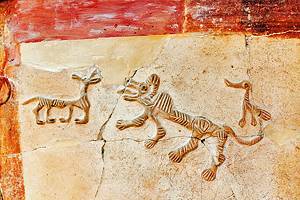
More History: While the Atatürk Mausoleum celebrates the birth of modern Turkey, the story of this land stretches right back to the early days of human history. South from Ankara, near Konya, you'll find the archaeological site of Çatalhöyük, one of the world's most important Neolithic sites, while near Ankara, and easily visited as a day trip from the capital, is the Phrygian necropolis of Gordion, home to the legend of the Gordion knot.



